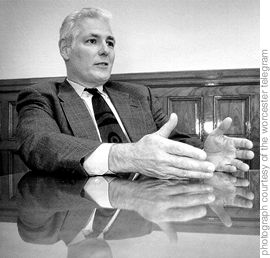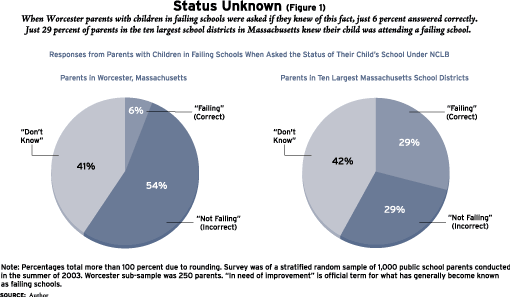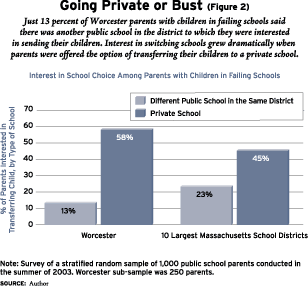
James Caradonio can barely contain his odium for the federal government’s latest efforts at education reform. The mere mention of the No Child Left Behind Act (NCLB) sparks a tirade: “Reductio ad absurdum, you know. But this is what we’re dealing with in terms of this insanity. Oh, it’s numbers and it looks great. We’ve got numbers. Simple. And it all looks great and it’s just killing, killing teachers and killing principals.” He should know. As the superintendent of schools in Worcester, Massachusetts, and the only superintendent to serve on the inaugural statewide NCLB Implementation Team, Caradonio possesses intimate knowledge of, and influence over, the law’s local successes and failures.
The impact of NCLB, which Caradonio terms the No Teacher Left Standing Act, was supposed to be felt most strongly in urban centers with large minority and disadvantaged populations-places just like Worcester. Instead, during its first two years, NCLB appeared to have little impact at all.
As of June 2003, 12 of Worcester’s 50 public schools had been labeled “in need of improvement” for two consecutive years, and five schools for three years in a row. During the 2002-03 school year, under the new law’s choice provisions, almost 4,700 students were entitled to transfer out of their failing schools and into one of the district’s higher-performing schools. Roughly 1,800 students had the right to use Title I funds to obtain supplemental academic services from qualified public or private providers, another carrot the new law extends to children enrolled in underperforming schools.
As of December 2003, however, only one child in Worcester had switched schools. And just one more had taken advantage of the supplemental services provision to obtain tutoring from a provider outside of the public school system.
For the most part, local officials have taken the fact that so few parents have switched schools or demanded private supplemental services as confirmation of the district’s excellence. But is there really no more than one family that wishes to change schools? If there are others, what is limiting their exercise of choice? And why aren’t parents taking advantage of the supplemental services by private providers that are guaranteed to them under the law?
Obviously, the implementation of any major piece of legislation proceeds in fits and starts, making it much too early to proclaim NCLB an unmitigated success or failure. Nevertheless, for reasons inherent in the writing of the law, districts’ incentives to implement it, and parents’ current knowledge of its provisions, early returns suggest that NCLB is not likely to revolutionize public education in Worcester anytime soon.
Already on the Move

Worcester is the third largest school system in the state of Massachusetts, serving roughly 25,000 students in 46 public schools (36 elementary, 4 middle, 5 high, and one pre-K-12 school). The federal government provides just 10 percent of the district’s $265 million annual budget, with state appropriations, local contributions, grants, and revolving funds covering the balance.
Worcester’s schools house an increasingly diverse and disadvantaged population of students. During the past two decades, the percentage of nonwhite students has more than doubled, from roughly 20 percent in 1980 to slightly more than 50 percent in 2002. The district provides 7 percent of its students, representing no fewer than 50 different languages, with English as a Second Language (ESL) tutorial programs. More than 50 percent of the district’s students qualify for the federal lunch program, a common measure of disadvantage. And on the Massachusetts Comprehensive Assessment System (MCAS)-the state’s standardized test, first administered in the spring of 1998-Worcester public school students in different grade levels were 8 to 20 percentage points less likely to score at or above proficiency than were students statewide.
Making matters worse, Worcester’s schools serve an extremely mobile population of families. Between 1999 and 2002, on average, 23 to 37 percent of elementary students changed schools within a given academic year; among middle schools, mobility rates ranged from 24 to 32 percent; and for high schools, from 24 to 28 percent. Much of this movement occurred across district lines. For instance, during the 2001-02 school year, 12 percent of Worcester elementary students changed schools and another 21 percent left the district altogether. That such a high proportion of Worcester’s families are moving in and out of the district exacerbates the problems of tracking students and delivering a coherent education program.
Schools that failed to meet their “adequate yearly progress” targets, as required by NCLB, serve some of the most mobile student populations. Among those elementary schools that were deemed in need of improvement between 1999 and 2001, mobility rates reached as high as 51 percent. When determining whether a school has made adequate progress, the state does not account for these mobility rates-a fact that almost every public official in the district is quick to point out. “You really can only determine whether you’re making progress or not if you’re testing the same kids, year after year,” says Worcester mayor Timothy Murray. “And that’s something that is not lost, I think, on parents or the School Committee.”
The causes of mobility vary widely, though by most accounts it has little to do with parents seeking better schools. As Brian O’Connell, vice chair of the city’s School Committee, notes, “Parents are moving from one apartment to another or husband and wife separate, mother and boyfriend separate, evictions take place, friends go off, parents move, parents are homeless, parents leave in November to go back to Puerto Rico and come back in the spring and come back to a different school.”
In short, even without satisfying the choice provisions of the new law, the Worcester school district must cope with a dizzying amount of movement in and out of its schools. Schools struggle just to keep track of their students from year to year. Moreover, the district already provides a significant amount of choice. During the 2002-03 school year, only 61 percent of students attended their neighborhood public school. The rest attended one of two charter schools or six citywide magnet schools, participated in the interdistrict choice program, or joined in the district’s desegregation plan.
Friendly Discouragement
Ultimately, districts are responsible for informing parents of their rights and opportunities under NCLB. But given the challenges that Worcester faces, along with the incentives to safeguard public finances, it should come as no surprise that administrators subtly, and not so subtly, discouraged families from transferring their children out of underperforming schools.
In the spring of 2003, the district notified families at underperforming schools of their rights under NCLB. The designation “in need of improvement,” the letters explained, “means that although these schools are succeeding in some areas, there is still room for growth.” After highlighting limitations of the NCLB grading system, the letter underscored unattractive features of the law’s choice provisions. For example, “In most instances, because of space limitations, we may not be able to transfer every child in a family to the same school.” Furthermore, the letter noted, families with children at underperforming schools who switch schools forfeit their rights to supplemental services.
The letter goes on to cite many exciting developments in Worcester public schools. “We believe that your child’s school is on its way towards achieving the NCLB goals. The principal and teachers at your child’s school have implemented new programs and services during the school day as well as after school. These include: a proven literacy approach designed to meet the individual needs of the students; the Everyday Mathematics program for students in grades K-6; an after-school program to help students improve MCAS scores; and other special programs.”
The district then set up a multistage procedure for parents to exercise their right to choose another school. The first step involves a meeting between a parent and her child’s principal, wherein the parent has an opportunity to explain why she is unhappy with her child’s school. The principal can then clarify the problems with NCLB and show why the family ought to stay put. Principals also explain why students are best served by receiving supplemental services within their schools. (The district offers an academically based after-school program for Title I students, which qualifies as supplemental services under NCLB. More than 800 students are currently enrolled in this program.)
Not surprisingly, very few parents requested a meeting with their principal. According to Elaine De Araujo, principal of Harlow Street Elementary School, “Nobody has wanted to change. Not one parent has come forward. If you were here, you would see why. You would see what a nurturing, wonderful place this is.” Ruthann Melancon, the principal of Elm Park Elementary School, notes, “A couple of parents came to me thinking that the school was going to close. I sat down with these sets of parents and reassured them. They’ve been here since preschool and they have liked what they’ve seen.” Under NCLB, both Harlow Street and Elm Park have failed to make adequate progress every year that the schools have been evaluated.
If, after consulting with the school principal, parents still want to change schools, they must schedule yet another meeting at the Parent Information Center. Robert Vartanian, the center’s director, say that he has met with just two families interested in NCLB choice, and only one of those families ended up switching their child to a different school. Each time, Vartanian has taken the opportunity to reiterate many of the points made by the school principal. Perhaps most consequentially, though, Vartanian informs parents that the district may not be able to accommodate their request to attend any specific school. Indeed, since the district is obligated only to offer parents a choice of two schools that did make adequate progress, that is all they can expect to receive. There are also no guarantees that either of these schools will be near the family’s home or that transportation will be provided over the longer term of a child’s education. As district official Joan Fitton explains, “The feds told us we had to offer a choice, not the parents’ choice, but a choice.”
Standing on the Sidelines
The Worcester district also uses its control over the flow of information to limit the influence of NCLB’s supplemental services provision. While the district can advertise its tutoring and after-school services directly to parents, private providers hoping to capture a piece of this market have few opportunities to get their foot in the door. As Seppy Basili, vice president of Kaplan K12 Learning Services, notes, “The school district is the owner of the relationship between provider and the parent. And I can’t get in.” The five companies with contracts to provide supplemental services in Massachusetts-Brainfuse (The Trustforte Corporation), Huntington Learning Centers, Kaplan K12 Learning Services, Princeton Review, and the Summit Educational Group-do not even know which students are eligible for Title I funding and, thus, supplemental services. Therefore they must rely on the district and its representatives to present their services to parents in as favorable a light as possible.
Curiously though, private providers are not complaining yet-at least publicly-perhaps for fear of alienating district administrators, on whose cooperation and goodwill they depend. Meanwhile, for some companies that provide private tutoring, the state-mandated amount involved ($1,238 per year, per student in Worcester) is simply insufficient to warrant serious investment.
For instance, Huntington Learning Centers, which have the distinct honor of having served the only Worcester student to obtain supplemental services from outside of the public school system, typically contract with families for 100 to 150 hours of individual tutoring. The Title I money available for supplemental services, however, covers just 30 to 40 hours of tutoring, which would require either an abbreviated or an entirely restructured program. Notes Mark Shobin, the owner of three Huntington franchises in Massachusetts, “From a financial perspective, it doesn’t make sense for us to try to corral these students into our program. We are happy to work with and develop programs for those students who seek us out. But I am not going to seek them out.”
Transportation problems further inhibit parents’ interest in sending their child to private providers. “We don’t provide transportation for supplemental services,” explains Joan Fitton. “And neither do the supplemental service providers provide transportation. So, there, right away, is a big glitch in the whole program. We’re not required to provide transportation. And, to be honest, to send money out of the district, I’m not sure that we would even offer to do that.” As long as children continue with their own school’s program, parents need not worry about transporting them across town during the middle of the day. The district benefits as well, since it avoids losing Title I funds to private providers.
What Parents Know and Want
Many parents in Worcester simply do not know much about their school’s performance or their rights under NCLB. In a telephone survey conducted during the summer of 2003, public school parents routinely expressed confusion over basic points of fact. Overall, 25 percent of parents surveyed in Worcester had children who attended underperforming schools. However, when asked whether their child’s school was on the list of underperforming schools, just 6 percent of parents said yes, 54 percent said no, and 41 percent said that they did not know (see Figure 1). Fully 93 percent of parents of children in underperforming public schools either did not know that their school was deemed in need of improvement or incorrectly thought that their child attended a school that had made adequate yearly progress.

As one might expect, levels of knowledge varied depending on parents’ socioeconomic status and ethnicity. Whereas 54 percent of whites knew whether their child attended an underperforming school, just 28 percent of African-Americans and Hispanics did. Just 26 percent of parents born outside of the United States and 17 percent of parents of children who receive English as a Second Language instruction knew whether their school was underperforming.
Are parents interested in choice? Among those with children in underperforming schools, just 13 percent said there was another public school in the district to which they were interested in sending their children (see Figure 2). By comparison, 8 percent of parents of children in schools that had made adequate yearly progress said they were interested in another school. Consistent with these responses, parents appeared to be satisfied with their public schools. Eighty-seven percent of parents with children in schools that made adequate progress gave their school an A or a B, as did 80 percent of parents with children in underperforming schools.

However, interest in choice spiked when the options included private schools. Fully 58 percent of parents with children in underperforming schools said that they would rather send their child to a private school than their current public school (see Figure 2), compared with 39 percent of parents with children in schools that made adequate progress. When asked, “If costs were not an obstacle, which type of school would you most like your child to attend?” 49 percent of parents with children in underperforming schools picked a private school, 44 percent a public school in their district, 4 percent a public school outside of the district, and just 2 percent a charter school.
The clause “if costs were not an obstacle” apparently freed up some parents’ imaginations to consider elite (read: expensive) private schools. When asked to name a preferred private school, roughly half named independent private schools (the most popular being Worcester Academy and Milton Academy), with tuitions that eclipse the values of even the most generous school vouchers offered in public and private programs across the country. The rest identified a Catholic or Protestant day school, most of which were located within or near the city of Worcester.
Misalignments of information, interests, and schooling options have effectively limited NCLB’s influence in Worcester. Those parents who qualify for public school choice and supplemental services are the least likely to know it; fewer than one in ten parents with children in schools that failed to make adequate progress could correctly identify their school’s status. Meanwhile, Worcester parents are most interested in pursuing schooling alternatives that NCLB does not furnish.
The Road Ahead
In Worcester distrust of NCLB runs rampant. While many principals extol the benefits of using student achievement data as a diagnostic tool, officials downtown remain deeply suspicious of the longer-term consequences that will accompany repeated failures to make adequate yearly progress. Notes Caradonio, “We’re screwed. This whole thing has been set up to make sure it looks bad so we can bring in the miracle drugs, the vouchers, and all this is very clear.” School Committee member Kathleen Toomey expressed much the same sentiment to the town newspaper. “[NCLB] is one way to promote flight out of city schools,” she said. “Proponents of charter schools will be able to say, -Look, see, those public schools are not working.’” Local officials have assumed a defensive posture, poised at every opportunity to minimize the impact of a law that they think is designed to set them up for failure.
Some short-term solutions may encourage higher participation rates. It is sheer folly, for instance, to expect school districts to vigorously implement an accountability scheme that disrupts their school assignment procedures, drains money from their coffers, and threatens their administrative autonomy. Until an independent organization is established that disseminates information about which schools are underperforming, which students qualify for choice and supplemental services, and which providers are available, there is little reason to expect that NCLB will induce an exodus of students from underperforming schools.
However, even if an independent agency were established, a massive reallocation of students and resources would be unlikely. The district will continue to pursue its strategies of blame avoidance. If the survey results are any indication, few qualifying families appear likely to switch to a different public school. And as the number of schools failing to make adequate progress grows, the number of options remaining for families will only dwindle.
-William G. Howell is an assistant professor of government at Harvard University.


